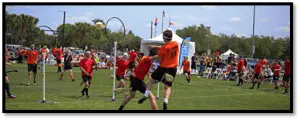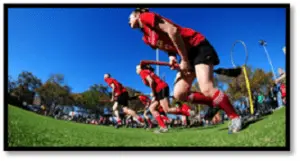
Have you ever considered going beyond these “usual suspects” to bring a whole new game experience to your students in PE?
My Health and Physical Education teacher candidates at the Ontario Institute for Studies in Education in Toronto did just that! For you Harry Potter Fans, Gina, James, and Taylor included Quidditch in their territorial games unit.
The teacher candidates were tasked with creating a 5-day, activity-based unit employing the principles of TGFU and Backward Design. They needed to demonstrate how movement competence exists on a continuum and is developed in a game-based context while focusing on the following:
- Movement Skill Acquisition (e.g. sending, receiving, retaining skills)
- Movement Concepts (e.g. body and spatial awareness, effort awareness, relationship with people, objects or within a particular environment)
- Game Strategies (e.g. maintaining and/or regaining possession, creating space, defending space) specific to a selected game category.
Unit and Lesson Planning using Backward Design Approach
1. Select a conceptual focus for a 5 day PE unit
- Emphasis on transferable movement skills, concepts, and game strategies in selected game unit (e.g. Territorial Games).
- Develop students’ game sense by building on tactical complexity from simple to complex as shown in Gina, James, and Taylor’s unit plan and lesson plan below.
2. Backward Design Question #1 – What will students learn?
- Include scope and sequence of essential learnings (curriculum expectations) within the unit.
- Include guiding questions to frame the students’ essential learning within the unit and lessons.
3. Backward Design Question #2 – How will we know students are learning?
- Include assessment opportunities throughout the unit that allow students to demonstrate what they know in a variety of ways (e.g., conversations, observations and products found in Gina, James, and Taylor’s lesson plan for Quidditch).
4. Backward Design Question #3 – How will assessment and instruction be organized for teaching and student learning?
- Identify learning goals in student-friendly language.
- Establish a positive learning environment, connecting to prior learning or experiences, setting the context for learning.
- Introduce new learning or extending/reinforcing prior learning, providing opportunities for practice and application for learning.
- Help students demonstrate what they have learned, providing opportunities for consolidation and reflection.
Territorial Games Unit and Quidditch
Featuring OISE’s Masters of Teaching Candidates Taylor Hilts, Gina Nicolopoulos, & James O’Brien
Course: PPL20 – 2015 Ontario Secondary Health and Physical Education Curriculum
Grade: 10
Unit/Conceptual Focus: Territory Games 5 Day Unit
Focus of Learning (Overall and Specific Curriculum Expectations):
Living Skills
1. Demonstrate personal and interpersonal skills and the use of critical and creative thinking processes as they acquire knowledge and skills in connection with the expectations in the Active Living, Movement Competence, and Healthy Living strands for this grade.
- 1.2 Use adaptive, management, and coping skills to help them respond to the various challenges they encounter as they participate in physical activities, develop movement competence, and acquire knowledge and skills related to healthy living.
- 1.3 Communicate effectively, using verbal or non-verbal means, as appropriate, and interpret information accurately as they participate in physical activities, develop movement competence, and acquire knowledge and skills related to healthy living.
Active Living
- A1. Participate actively and regularly in a wide variety of physical activities, and demonstrate an understanding of factors that can influence and support their participation in physical activity now and throughout their lives.
- A1.3 Demonstrate positive social behaviours and adherence to ethical and fair play standards that contribute to creating a rewarding and enjoyable environment for participation in physical activities.
- A3. Demonstrate responsibility for their own safety and the safety of others as they participate in physical activities.
- A3.1 Demonstrate behaviours and apply procedures that maximize their safety and that of others in a variety of physical activity settings.
Movement Competence
B1. Perform movement skills, demonstrating an understanding of the basic requirements of the skills and applying movement concepts as appropriate, as they engage in a variety of physical activities.
- B1.2 Perform locomotor and manipulative skills in combination in a variety of physical activities while responding to external stimuli.
- B2. Apply movement strategies appropriately, demonstrating an understanding of the components of a variety of physical activities, in order to enhance their ability to participate successfully in those activities.
- B2.1 Demonstrate an understanding of the components of a range of physical activities, and apply this understanding as they participate in a wide variety of physical activities, in a range of indoor and outdoor environments.
- B2.2 Apply analytical and problem-solving skills to identify and implement tactical solutions that will increase their chances of success as they participate in a variety of physical activities.
Guiding Questions for Unit:
- What do you have to do to maintain possession?
- What do you have to do to send or receive a pass?
- What do you have to do as a team to cover areas on a court/field to make it difficult for the team on offense to get close to the defending team’s goal?
- When in possession of the object, what did you have to do to put pressure on the other team’s goal by shooting or passing the object at or towards the goal or goal line?
- How does individual locomotion affect the game?
- How does teamwork and communication affect success in game-like situations?
- What are some safety risks that can be associated with territorial games?
Lesson # 1 Focus: Group Juggling/Five Pass/Speed Pass
Specific Focus:
- Passing
- Maintaining possession
- Marking a player
Lesson # 2 Focus: Four Corners/Ultimate Frisbee
Specific Focus:
- Maintaining possession
- Advancing to score
- Defending a space
Lesson # 3 Focus: Pinball/European Handball
Specific Focus:
- Shooting to score
- Defending a goal
Lesson # 4 Focus: Speedball
Specific Focus:
- Shooting to score
- Defending a goal
- Quidditch prep: watch video link
Lesson # 5 Focus: Quidditch (View Full Lesson Plan)
Specific Focus:
- Shooting to score
- Defending a goal
- Spatial awareness/dodging
Have fun and Quidditch on!



 1. Demonstrate personal and interpersonal skills and the use of critical and creative thinking processes as they acquire knowledge and skills in connection with the expectations in the Active Living, Movement Competence, and Healthy Living strands for this grade.
1. Demonstrate personal and interpersonal skills and the use of critical and creative thinking processes as they acquire knowledge and skills in connection with the expectations in the Active Living, Movement Competence, and Healthy Living strands for this grade. B1. Perform movement skills, demonstrating an understanding of the basic requirements of the skills and applying movement concepts as appropriate, as they engage in a variety of physical activities.
B1. Perform movement skills, demonstrating an understanding of the basic requirements of the skills and applying movement concepts as appropriate, as they engage in a variety of physical activities.
